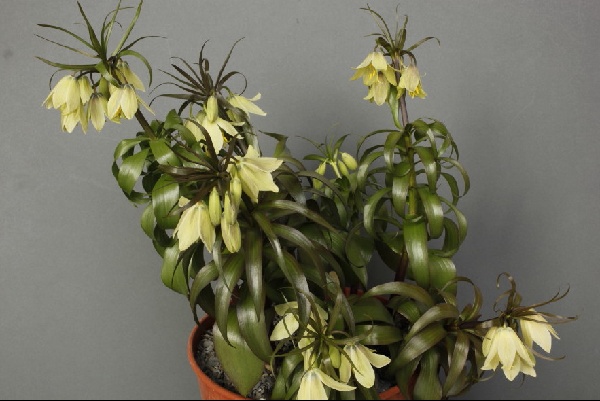Early Spring AGS Show, 2009
Following a good cold winter, even in the south, many pots of bulbs and other plants seemed to have their flowering better synchronised than usual. Although the benches were perhaps not as full as they could be, there were a wide range of exhibits including snowdrops, crocuses, narcissus, dionysias, primulas, saxifrages and cyclamens.
Although some of the larger dionysias were not able to cover their cushions completely with flowers there was a range of interesting species and hybrids shown. I was particularly impressed by the D. afghanica hybrids shown by Hans Kaupert and Paul and Gill Ranson in various classes. These hybrids usually show the dark eye typical of D. afghanica, which seems to add that extra something to the flower. With the exception of “Gnom” , these hybrids had all been selected by Michael Kammerlander from open-pollinated plants, with the most likely pollen parent ascribed to each cross.

There were not many fritillaries benched – a little early for many species. There was a good pan of F.raddeana shown by Bob and Rannveig Wallace. Unlike its larger relative F. imperialis, this species has delicately-scented flowers and is much more suited to pot culture. The species comes from north-east Iran and south Turkmenistan, growing on north-facing stony slopes – giving an indication as to its requirements in cultivation.
Don Peace exhibited a huge plant of Primula “Arduaine”. There is a definite challenge to growing on a single plant over years, rather than filling a pan with a number of young plants. The plant shown had at least twenty rosettes, with even flowering over the plant. Don grows his petiolarids in a mix of leafmould and perlite and keeps them out of direct sunlight.
I am a fan of the hardier South African bulbs, and an interesting species was shown by Cecilia Coller. Massonia echinata is one of a small number of species in a genus which is relatively straightforward in cultivation. Plants can flower in about three years from seed, and survive well in an open compost. The plants will take a few degrees of frost. The species are summer dormant, coming into growth from autumn onwards, depending on when watering is started. Mine flower between December and February, and most species have a wonderful scent that fills the greenhouse. The species shown lacks the white petals that most of the other species have, and it produces, from its ground-level flowers, copious amounts of nectar to attract rodents, which are its main pollinator.
Certificates of Merit were awarded to three plants. The first went to a pan of Scoliopus hallii shown by Jean Rich. This was a splendid well-flowered pan full from seed sown in 2001.
The second certificate was awarded to a hardy cymbidium, C. goeringii, shown by Wilma and Jim Wright.
The third went to Ray Drew’s spectacular Adonis “Fukujukai”.
